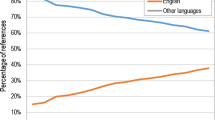Abstract
China has greatly increased the number of published works indexed in the Web of Science since 1980. This corpus of scholarship allows analysis of the creativity or innovation of that contribution, where creativity is indicated by deep conventionality and high novelty. A test is applied to analyze reference pairs in articles to search for unexpected referencing combinations at the journal–journal level. The method has shown that atypical reference pairs occur in more highly cited articles. Using articles with at least one Chinese address as indexed in Web of Science for the publication year 2007, we tagged articles based on the conventionality and novelty of the reference pairs, seeking, in particular, those articles that reveal atypicality. This atypical set of articles represented 8% of all Chinese articles, compared to the world level of 7% in 2005. China’s atypical work is also more highly cited than a similar set of records at the world level for the years 1980–2000. The findings suggest that China has advanced in its goals of establishing itself as a full participant in global science and technology.





Similar content being viewed by others
Notes
Possible explanations are offered in the referenced article. The most likely explanation is due to the higher reputation of international collaborators and the fact that they may be more conservative in approach.
References
Appelbaum, R. P., Cao, C., Han, X., Parker, R., & Simon, D. (2018). Innovation in China: Challenging the global science and technology system. Hoboken: Wiley.
Boyack, K. W., & Klavans, R. (2014). Atypical combinations are confounded by disciplinary effects. Proceedings of the Science and Technology Indicators Conference 2014, (September), 64–71.
Cao, C., Baas, J., Wagner, C. S., & Jonkers, K. (2020). Returning scientists and the emergence of China’s science system. Science and Public Policy,47(2), 172–183. https://doi.org/10.1093/scipol/scz056.
Galunic, D. C., & Rodan, S. (1998). Resource recombinations in the firm: Knowledge structures and the potential for schumpeterian innovation. Strategic Management Journal,19(12), 1193–1201.
Gazni, A., Sugimoto, C. R., & Didegah, F. (2012). Mapping world scientific collaboration: Authors, institutions, and countries. Journal of the American Society for Information Science and Technology,63(2), 323–335. https://doi.org/10.1002/asi.21688.
Kaplan, S., & Vakili, K. (2015). The double-edged sword of recombination in breakthrough innovation. Strategic Management Journal,36(10), 1435–1457.
Larivière, V., Gingras, Y., Sugimoto, C. R., & Tsou, A. (2015). Team size matters: Collaboration and scientific impact since 1900. Journal of the Association for Information Science and Technology,66(7), 1323–1332. https://doi.org/10.1002/asi.23266.
Leydesdorff, L., Wagner, C. S., & Bornmann, L. (2014). The European Union, China, and the United States in the top-1% and top-10% layers of most-frequently cited publications: Competition and collaborations. Journal of Informetrics,8(3), 606–617. https://doi.org/10.1016/j.joi.2014.05.002.
Organization for Economic Cooperation and Development. (OECD). (2019). Main science and technology indicators. Retrieved May 2020, from https://data.oecd.org/rd/gross-domestic-spending-on-r-d.htm.
Merton, R. (1973). The sociology of science. Chicago: University of Chicago Press.
Merton, R. K. (1968). The Matthew effect in science. Science,159(3810), 56–63. https://doi.org/10.1126/science.159.3810.56.
Moed, H. (2002). Measuring Chinas research performance using the science citation index. Scientometrics,53(3), 281–296.
Mongeon, P., & Paul-Hus, A. (2016). The journal coverage of web of science and scopus: A comparative analysis. Scientometrics,106(1), 213–228.
Mukherjee, S., Uzzi, B., Jones, B., & Stringer, M. (2016). A new method for identifying recombinations of existing knowledge associated with high-impact innovation. Journal of Product Innovation Management,33(2), 224–236. https://doi.org/10.1111/jpim.12294.
Rheingold, H. (1985). Tools for thought: The people and ideas behind the next computer revolution. New York: Simon & Schuster Trade.
Simandan, D. (2018). Being surprised and surprising ourselves: A geography of personal and social change. Progress in Human Geography,44(1), 99–118. https://doi.org/10.1177/0309132518810431.
Uzzi, B., Mukherjee, S., Stringer, M., & Jones, B. (2013). Atypical combinations and scientific impact. Science,342(6157), 468–472. https://doi.org/10.1126/science.1240474.
Wagner, C. S., Whetsell, T. A., & Mukherjee, S. (2019). International research collaboration: Novelty, conventionality, and atypicality in knowledge recombination. Research Policy. https://doi.org/10.1016/j.respol.2019.01.002.
Weisberg, R. W. (1999). Creativity and knowledge: A challenge to theories. Handbook of creativity (pp. 226–250). New York, NY: Cambridge University Press.
Whitley, R. (2000). The intellectual and social organization of the sciences. Oxford: Oxford University Press on Demand.
Zhou, K. Z. (2006). Innovation, imitation, and new product performance: The case of China. Industrial Marketing Management,35(3), 394–402. https://doi.org/10.1016/j.indmarman.2005.10.006.
Zhou, P., & Leydesdorff, L. (2006). The emergence of China as a leading nation in science. Research Policy,35(1), 83–104.
Funding
Xiaojing Cai would like to acknowledge the support from Fulbright Foreign Student Program, the National Natural Science Foundation of China (Grant number: 71843012) and the major basic theoretical research project of Zhejiang University (Grant number 16ZDJC003).
Author information
Authors and Affiliations
Contributions
CW: Concept, writing; XC: Data analysis and visualization; SM: methodology and data analysis.
Corresponding author
Ethics declarations
Conflict of interest
The author(s) declare that they have no competing interests.
Rights and permissions
About this article
Cite this article
Wagner, C.S., Cai, X. & Mukherjee, S. China’s scholarship shows atypical referencing patterns. Scientometrics 124, 2457–2468 (2020). https://doi.org/10.1007/s11192-020-03579-2
Received:
Published:
Issue Date:
DOI: https://doi.org/10.1007/s11192-020-03579-2




